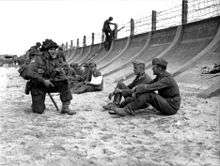716th Static Infantry Division (Wehrmacht)
| 716th Infantry Division (Static) | |
|---|---|
 Wehrmacht 716 Infantry Division insignia | |
| Active | 1941–1945 |
| Country |
|
| Branch | Heer |
| Type | Static Infantry |
| Role | Coastal Defence |
| Size | Division (~8,000 men) |
| Engagements | Invasion of Normandy |
| Commanders | |
| Notable commanders | Generalleutnant Wilhelm Richter |
The 716th Static Infantry Division (German: 716. Infanterie-Division) was a World War II, German Army Division. It was raised on May 2, 1941 and sent to German-occupied France in June 1941. Many of the Division's troops were elderly Germans and conscripts from other German occupied countries, especially Ukrainians. As such it was not equipped with the standard configuration of vehicles and heavy weapons. Much of the Division’s artillery and anti-tank guns were from captured armaments.
Divisional history
Formed in Bielefeld, the Division was transferred to Rouen in France for training. Following this, the Division was deployed along the Normandy coast in May 1942. Its duties included coastal defense, air raid protection and defensive fortification construction. After a short period of deployment to Amiens and Brussels the Division was transferred to Caen. The Division would face Allied forces during D-Day on June 6, 1944.
The 716th Division covered the Normandy coast north of Caen, from the mouth of the River Orne in the east to the Carentan Estuary in the west. As such the Division had elements present on Omaha, Gold, Juno and Sword Beaches. An artillery regiment was stationed at the Merville Battery. They were also charged with guarding what became known as Pegasus Bridge and as such were likely to be the first German ground troops in action on D-Day.
During the fighting after D-Day, the Division fought defensively around Caen and Villers-Bocage. According to the commanding officer, Generalleutnant Wilhelm Richter, "My division had been defeated and badly beaten up in Normandy". The Division was removed from frontline duty on July 10, 1944 and luckily avoided the carnage of the Falaise Pocket.
Redeployed to the south of France, the Division took up coastal security positions in the region of Salses-Perpignan-Elne, close to the Spanish border. Thereafter, the Division was ordered to withdraw on August 19, 1944 and retreated through Languedoc to the region around Lyon. After this movement the Division was engaged by the French resistance before later arriving in the area of Sélestat in Alsace.
In October 1944 the 716th Infantry Division was in the region of Oberrhein (near Colmar) where it fought at Neunkirch-Obenhein and was nearly wiped out in heavy fighting in January 1945. The remains of the Division was reconstituted as the 716th Volksgrenadier Division in April 1945 before surrendering to American units at Kempten in May 1945.
Order of battle

The 716th's complement when raised in 1941 was:
- Divisional Staff
- 726 Infantry Regiment
- 736 Infantry Regiment
- 716 Artillery Regiment
- 716 Panzerjaeger Company
- 716 Pioneer Battalion
- 716 Signals Battalion
- 716 Supply Troops
- Administration Platoon

See also
- Volksgrenadier
- Division (military), Military unit, List of German divisions in World War II
- Heer, Wehrmacht
References
- Zetterling, Niklas (2005). "German Order of Battle in Normandy". Retrieved July 25, 2008
